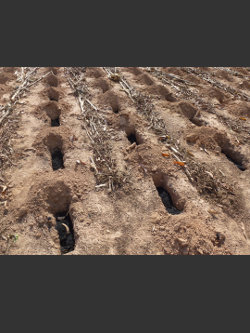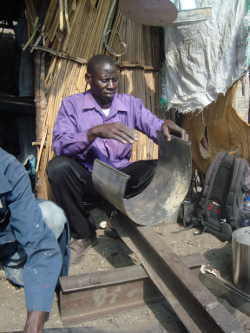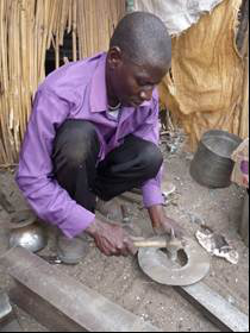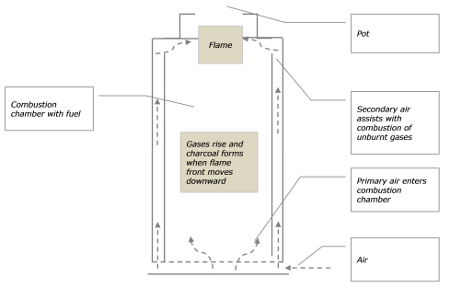The Peko Pe
The Peko Pe stove converts biomass to a smokeless flame for use in cooking and heating of living quarters. The stove belongs to the TLUD-ND (Top Lit Up Draft – Natural Draft) category of clean burning stoves.
TLUD stoves operate on the principles of pyrolysis and gasification for production of heat and biochar and is in essence therefore microkilns. The main idea behind the stove is that it should be simple to construct and operate. The stove operating principles is that pyrolysis and gasification and where these are coupled with the stoves simplistic design to yield a stove that permits many different types of biomass, such as corn cobs, chopped wood, a variety of nut shells, straw, etc. The stove’s flexibility with regard to biomass allows end-users to choose between different sources of biomass; many of these categorized as waste products having a low or no cost.
The simple design and construction, based on natural draft combustion principles and assembled in an uncomplicated manufacturing process, makes the stove easily accepted by local tinsmiths.
History of the Peko Pe
The thematic design principles of the stove dates back to the early days of World War two. Paal Wendelbo, then a teenager, accompanied hunters and members of the resistance movement hiding in the forest. To avoid being spotted, there was a need for small wood fires with little smoke to cook meals and as a source of heat. Later, as a humanitarian, working in Africa in the 1980s, Paal Wendelbo observed the health and environmental issues caused by cooking over open fires and introduced the Peko Pe stove in refugee camps in Africa in the 1990'ies. Wendelbo worked from 1984 to 1990 with different stove programs for different NGOs in Mozambique, Ghana, Zambia, Ethiopia, Kenya, Tanzania, Uganda and China. He saw forests exploited for firewood and charcoal and the stove was developed over an extended period of time and first introduced in the East Moyo refugee camp in Adjumani in Uganda in 1995. In this camp the stove was adopted and in use using Hyperhenia Rufa grass as feedstock. The women in the camp named it Peko Pe, which in the local Acholi language means “It will solve our problems” or "no problem". For the women, the stove's alternative use of stove fuel near the camp, meant that they did not have to take long and dangerous trips into the forest to collect firewood and being exposed to inhuman acts.
In 1999 Paal Wendelbo was hit with malaria and suffered much from the disease. And struck with ill health, no significant stove projects were established in the period from end of the 1990’ies to the end of the 2000’es. In 2005 Wendelbo initiated a partnership with the Norwegian organization Miombo on project origination and stove distribution.
Wendelbo together with Tom B. Reed are credited, for independently of each other, to invent and develop the principle of TLUD stoves. TLUDs are in certain stove communities spoken of as microgasifiers and are biochar producing stoves.
Design of the Peko Pe
The construction principle for TLUD stoves is shown in the figure. The downward movement in the fuel of the flame or pyrolysis front causes the formation of a) carbon also denoted biochar and b) gases. The gases react first with the carbon or the biochar, for then to move upwards in the fuel. At the top of the stove, the gases meet secondary air, securing a clean combustion for production of heat for living quarters or heat for cooking.
The stove consists of an inner combustion chamber with a bottom plate, four legs, outer cylinder, two handles, top lid and a three pot stand. Primary air intake limits the volume of air into lower part of the stove, but sufficient to keep air flow and maintain the biomass gasification process to run continuously. A gap between the combustion chamber and the top lid secures secondary air for mixing of gases and complete combustion.
There are two main processes that occur in a TLUD. One is the decomposition of the biomass to smaller units. This is the pyrolysis process where biomass is broken apart to elementary particles, gases primarily carbon dioxide, nitrogen and water. In the following process, gasification, the gases will be exposed to the carbon, and converted to carbon monoxide and hydrogen. These gases flow upwards through the fuel, combines with secondary air, and ignites at the top and are combusted.
Production of Peko Pe
It is recommended to manufacture the Peko Pe in acid proof stainless steel to assure long life span. The use of acid proof stainless steel is up to five times more expensive than mild steel, and market preferences will determine the choice between the two materials. The expected life span of the stove with acid proof stainless steel is expected to be of about 10 years.
The Peko Pe is characterized by simple design and uncomplicated assembly, matched to the skills of trained tinsmiths, a common trade in e.g. Africa. The tool requirement for a Peko Pe assembly is low and standard outfit with tinsmiths. Typical tools are: simple hand tools, hammer, metal scissor, spikes, screw driver, truck springs or parts of a railway line.
Normally a tinsmith will assemble a Peko Pe stove in a little more than one hour. Quality assurance may be implemented using pre-fabricated flat-packs. Flat-packs function as templates and facilitates a standardized metal material and size on the stove parts.




